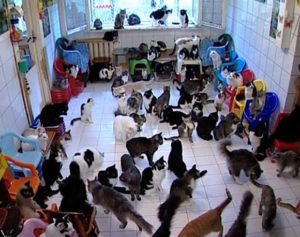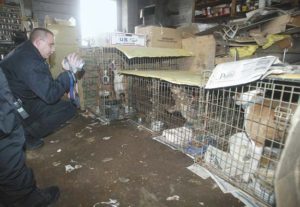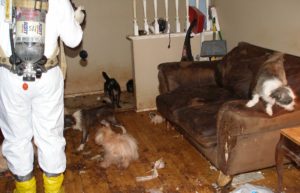
In Judeo/Christian literature the word “sin” originates from the idea of “missing the mark”. Our understanding of missing the mark has been explained by theologians through the ages as resulting from sins of commission and sins of omission.
While pondering this idea, I wondered how the concept of sin, or “missing the mark”, might apply to our responsibility for the environment and the animals who inhabit it. It occurred to me that there are three deadly sins we commit when we fail in our responsibility for animals: cruelty, neglect, and hoarding.
- Cruelty is the sin of commission, an overt act of hurting an animal;
- Neglect is the sin of omission, not providing for the needs of an animal’s well-being; and
- Hoarding, perhaps the most insidious of the three sins. Hoarding is a combination of cruelty and neglect disguised as love; but is, in fact, hurtful, self-serving avarice.
That being the case, I decided to devote this blog to better understanding the sin of hoarding.

Despite assertions of love, hoarders neglect their animals by not providing needed medical care or even the minimum basic necessities of adequate food, water, and shelter. I italicize their in the previous sentence to call attention to a hoarder’s deranged sense of ownership. Blind to the suffering they inflict on their animals they insist that they alone are capable of loving and caring for them. The tragedy is that they too often love their animals to a ghastly death. Neglected, untreated and uncared for, their animals, their diseases and their cruelty multiply.
Despite a plethora of studies on the topic, hoarding remains a largely misunderstood phenomenon in too many communities. This is due to a common perception that hoarders are simply Good Samaritans whose intentions or efforts have gone awry due to their caring so much. Hoarding is a psychological disorder evidenced by a persistent difficulty to discard or part with possessions because of a perceived need to save them. A person with an animal hoarding disorder experiences extreme distress at the thought of ever releasing animals from their “care” and are incapable of recognizing how mercilessly their animals are being treated.

It is critical that public health and law enforcement agencies and individuals responding to hoarding cases understand the severe animal, human, and economic harm hoarders cause.
The good news is there have been many studies regarding the cause and effect of hoarding in recent years. Today there is little excuse for public health and law enforcement officials not to understand the characteristics animal hoarders share and the psychological conditions that may trigger this behavior.

In many communities, law enforcement is increasingly better equipped to prosecute animal hoarders and deploy intervention programs but there is much work yet to be done. It is important that agencies and individuals affected by animal hoarders’ behavior find ways to proactively communicate and work together to prevent or end the hoarding and hurting in their community.
The more we understand this obsessive compulsive disorder the better equipped we will be as a community to help both the victimized animals and the hoarders themselves.
According to the Hoarding of Animals Research Consortium, an independent group of academic researchers based in Massachusetts, the following criteria are used to define animal hoarding:
- An individual possesses more than the typical number of companion animals.
- The individual is unable to provide even minimal standards of nutrition, sanitation, shelter and veterinary care, with this neglect often resulting in starvation, illness and death.
- The individual is in denial of their inability to provide this minimum care and the impact of that failure on the animals, the household and human occupants of the dwelling.
The full definition and more information on hoarding can be found at: vet.tufts.edu/hoarding.
